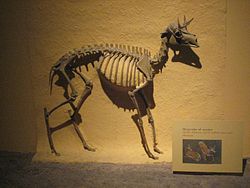Merycodontinae
| Merycodontinae | |
|---|---|

| |
| Merycodus | |
| Scientific classification | |
| Kingdom: | Animalia |
| Phylum: | Chordata |
| Class: | Mammalia |
| Order: | Artiodactyla |
| Family: | Antilocapridae |
| Subfamily: | †Merycodontinae |
| Genera | |
Merycondontinae is a subfamily of pronghorn that arose during the middle of the Miocene and became extinct by the end of that period.

The Merycondontinae were small, slightly built, fast-running ungulates. Both males and females were horned.
The genera Meryceros and Submeryceros are generally regarded as synonymous with Merycodus.[1][2]
Evolution
[edit]Merycodontines were indirectly adversely affected by the expansion of C4 grasslands in the Miocene because this evolutionary radiation increased speciation among antilocaprines, which likely caused some degree of ecological displacement in the former subfamily. Furthermore, proboscideans may have also contributed to the decline of merycodontines by inhibiting their speciation rate.[3]
References
[edit]- ^ Janis, Kathleen M. (1998). Evolution of Tertiary Mammals of North America: Volume 1, Terrestrial Carnivores, Ungulates, and Ungulate Like Mammals. Cambridge University Press. p. 496.
- ^ Prothero, Donald R. (2007). The Evolution of Artiodactyls. Johns Hopkins University Press. p. 232. ISBN 9780801887352.
- ^ Nascimento, João C. S.; Pires, Mathias Mistretta (4 May 2025). Parins-Fukuchi, Tomomi; Morlon, Hélène (eds.). "Open ecosystems expansion, competition, and predation shaped the evolution of Antilocapridae". Evolution. doi:10.1093/evolut/qpaf091. ISSN 0014-3820. Retrieved 18 September 2025 – via Oxford Academic.
- Byers, John A.; American Pronghorn: Social Adaptations & the Ghosts of Predators Past; University of Chicago Press; 1998